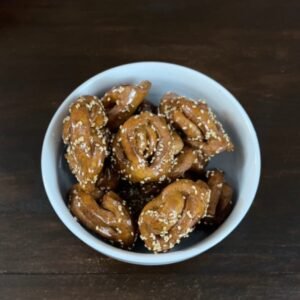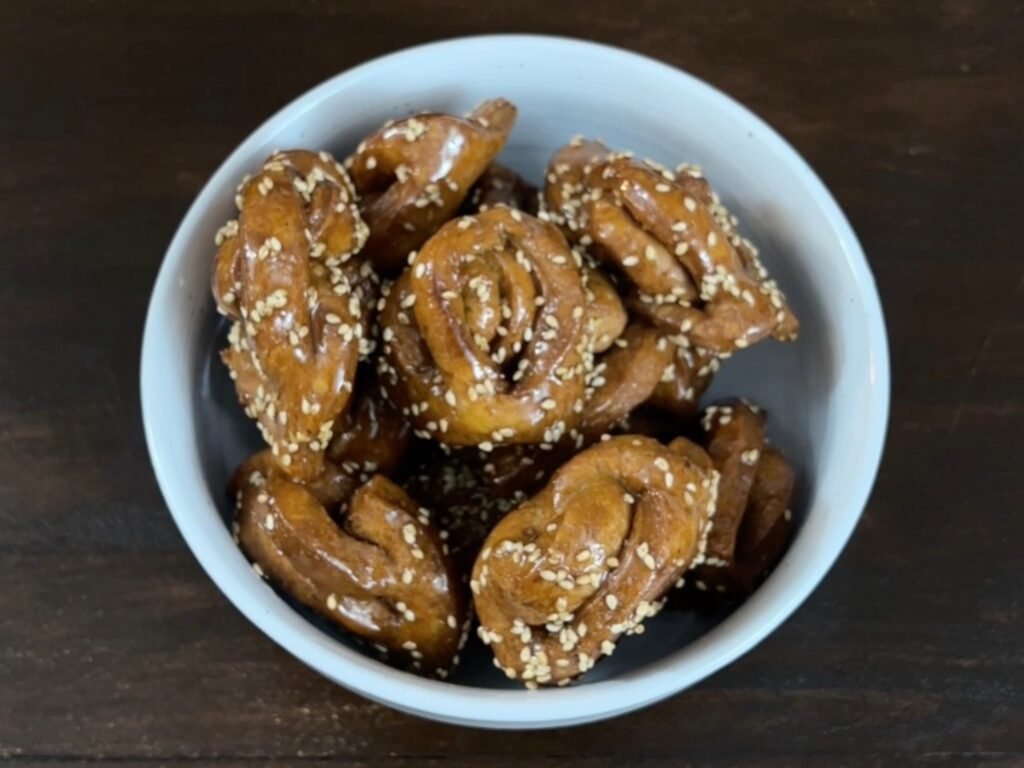No products in the cart.
How to Make Moroccan Chebakia
With its intricate design and irresistible blend of flavors, Chebakia is a staple in Moroccan cuisine, especially during special occasions such as Ramadan. Made from a dough infused with aromatic spices like anise, sesame seeds, and orange blossom water, it is then deep-fried until golden brown and crispy. The pièce de résistance comes in the form of a drizzle of honey syrup and a sprinkling of toasted sesame seeds.
Not only is Chebakia a delight to the eyes, but it also delights the taste buds with its unique balance of sweet and spicy flavors. This Moroccan delicacy is a perfect accompaniment to a cup of mint tea or can be enjoyed on its own as a delicious snack.
Whether you’re an experienced baker looking to expand your culinary repertoire or a newcomer to Moroccan cuisine, this step-by-step guide will help you master the art of making Moroccan Chebakia. Get ready to indulge in a taste of Morocco like never before.
History and Significance of Moroccan Chebakia
Moroccan Chebakia has a rich history and holds great significance in Moroccan culture. It is believed to have originated in the royal kitchens of the Maghreb, where skilled chefs would create intricate pastries to impress the ruling elite. Over time, Chebakia became a popular treat enjoyed by people of all backgrounds, particularly during religious festivals such as Ramadan.
The shape of Chebakia is said to resemble a rose, symbolizing beauty and love. It is often served as a gesture of hospitality and is an integral part of Moroccan hospitality. In fact, it is customary to offer Chebakia to guests as a sign of welcome and respect.

How to Make Moroccan Chebakia
Print Recipe Pin RecipeWith its intricate design and irresistible blend of flavors, Chebakia is a staple in Moroccan cuisine, especially during special occasions such as Ramadan.
Kitchen equipment list
- 1 Mixing bowl
- 1 frying pan
- 1 Baking sheet
Ingredients
- 500 All-purpose flour
- 100 Toasted sesame seeds
- 1 tsp Ground anise seeds
- 1 tsp Ground cinnamon
- ½ tsp Ground ginger
- ½ tsp Ground nutmeg
- ½ tsp Salt
- 50 grams Unsalted butter, melted
- 100 milliliters Vegetable oil
- 150 milliliters Orange blossom water
- 50 grams Yeast
- 100 grams Honey
- Vegetable oil for deep frying
Instructions
- In a large bowl, combine the flour, toasted sesame seeds, ground anise seeds, ground cinnamon, ground ginger, ground nutmeg, and salt. Mix well to ensure the spices are evenly distributed throughout the flour.
- In a separate bowl, dissolve the yeast in warm water and let it sit for 5 minutes until it becomes frothy. This indicates that the yeast is active.
- Add the melted butter, vegetable oil, and orange blossom water to the yeast mixture. Mix well to combine.
- Gradually add the wet ingredients to the dry ingredients, stirring continuously until a dough forms.
- Knead the dough on a lightly floured surface for about 10 minutes until it becomes smooth and elastic.
- Divide the dough into small portions and roll each portion into a thin rectangle.
- Using a pastry cutter or a knife, cut the dough into strips about 4-5 inches long and 1 inch wide.
- Twist each strip of dough into a decorative shape, resembling a flower or a pretzel. Ensure the dough is tightly sealed to prevent it from unraveling during frying.
- Heat vegetable oil in a deep fryer or a large pot to a temperature of 180°C (350°F).
- Carefully place the shaped dough into the hot oil, frying them in batches until they turn golden brown and crispy. This should take about 2-3 minutes per batch.
- Once fried, remove the Chebakia from the oil using a slotted spoon and drain them on a paper towel to remove any excess oil.
- In a small saucepan, heat the honey over low heat until it becomes thin and runny.
- Dip each piece of fried Chebakia into the warm honey, ensuring they are fully coated.
- Sprinkle the Chebakia with toasted sesame seeds while the honey is still sticky.
- Allow the Chebakia to cool completely before serving.
❋ Kitchen Chaos Unlocked Tips
Tips and Tricks for Perfecting Your Moroccan Chebakia
- Make sure the dough is well-kneaded to achieve a smooth and elastic texture.
- When frying the Chebakia, ensure the oil is at the right temperature to prevent them from becoming greasy or undercooked.
- For a more pronounced flavor, toast the sesame seeds before adding them to the dough.
- Be creative with the shapes of the Chebakia. Experiment with different designs to create a visually appealing platter.
- Allow the Chebakia to soak in the honey syrup for a few minutes before serving to enhance the flavors.
Nutrition
Serving: 20 gCalories: 85 kcalCarbohydrates: 13 gProtein: 1 gFat: 4 g
Tried this recipe? Mention @KitchenChaosUnlocked or tag #KitchenChaosUnlocked!
Variations and Adaptations of Moroccan Chebakia
While the traditional Moroccan Chebakia recipe is a time-honored classic, there are variations and adaptations that you can explore to add your own twist to this delicious treat. Here are a few ideas:
- Replace the anise seeds with fennel seeds for a slightly different flavor profile.
- Experiment with different spices such as cardamom or cloves to create a unique blend of flavors.
- Add a pinch of saffron to the dough for a vibrant yellow color and a subtle floral taste.
- Instead of deep-frying, try baking the Chebakia for a healthier alternative.
Serving and Storing Moroccan Chebakia
Moroccan Chebakia is best served at room temperature. Arrange them on a platter and garnish with a sprinkle of powdered sugar or additional toasted sesame seeds for an extra touch of elegance.
Store leftover Chebakia in an airtight container at room temperature for up to a week. The honey syrup acts as a natural preservative, keeping the Chebakia fresh and delicious.
Traditional Moroccan Chebakia Recipes from Different Regions
Morocco is a country rich in culinary diversity, and each region has its own unique twist on Chebakia. Here are a few traditional recipes from different regions:
- Fez-style Chebakia: This version is known for its elaborate shapes and delicate flavor. It often incorporates almonds or pistachios for added texture.
- Marrakech-style Chebakia: Marrakech is famous for its vibrant food scene, and the Chebakia reflects this. It is often flavored with orange blossom water and topped with a dusting of ground cinnamon.
- Casablanca-style Chebakia: In Casablanca, Chebakia is often made with semolina flour, giving it a slightly grainy texture. It is also known for its generous use of honey syrup.
Moroccan Chebakia in Popular Culture
Moroccan Chebakia has gained recognition beyond Morocco’s borders and has found its way into popular culture. It has been featured in various cooking shows and magazines, captivating audiences with its intricate design and delectable flavors. Chebakia is now a sought-after dessert in many Moroccan restaurants worldwide, allowing people from different cultures to experience the magic of Moroccan cuisine.
Conclusion: Enjoying and Sharing Moroccan Chebakia
Making Moroccan Chebakia is a labor of love, but the end result is well worth the effort. The combination of aromatic spices, crispy texture, and sweet honey syrup makes this treat truly irresistible. Whether you’re celebrating a special occasion or simply indulging in a moment of culinary delight, Moroccan Chebakia is sure to transport you to the vibrant streets of Morocco.
So gather your ingredients, follow the step-by-step instructions, and embark on a culinary adventure that will delight your taste buds and impress your guests. Share the joy of Moroccan Chebakia with your loved ones and spread the flavors of Morocco to your kitchen. Get ready to savor every bite of this delightful Moroccan delicacy. Shukran (Thank you) and enjoy!

